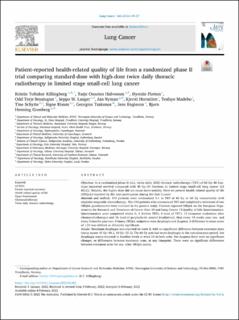| dc.contributor.author | Killingberg, Kristin Toftaker | |
| dc.contributor.author | Halvorsen, Tarje Onsøien | |
| dc.contributor.author | Fløtten, Øystein | |
| dc.contributor.author | Brustugun, Odd Terje | |
| dc.contributor.author | HORNSLIEN, KJERSTI | |
| dc.contributor.author | Madebo, Tesfaye | |
| dc.contributor.author | Langer, Seppo W. | |
| dc.contributor.author | Schytte, Tine | |
| dc.contributor.author | Risum, Signe | |
| dc.contributor.author | Tsakonas, Georgios | |
| dc.contributor.author | Nyman, Jan | |
| dc.contributor.author | Engleson, Jens | |
| dc.contributor.author | Grønberg, Bjørn Henning | |
| dc.date.accessioned | 2022-12-14T10:24:11Z | |
| dc.date.available | 2022-12-14T10:24:11Z | |
| dc.date.created | 2022-03-30T09:15:10Z | |
| dc.date.issued | 2022 | |
| dc.identifier.citation | Lung Cancer. 2022, 166 49-57. | en_US |
| dc.identifier.issn | 0169-5002 | |
| dc.identifier.uri | https://hdl.handle.net/11250/3037652 | |
| dc.description.abstract | Objectives
In a randomized phase II trial, twice daily (BID) thoracic radiotherapy (TRT) of 60 Gy/40 fractions improved survival compared with 45 Gy/30 fractions in limited stage small-cell lung cancer (LS SCLC). Notably, the higher dose did not cause more toxicity. Here we present health related quality of life (HRQoL) reported by the trial participants during the first 2 years.
Materials and methods
170 patients were randomized 1:1 to TRT of 45 Gy or 60 Gy concurrently with cisplatin/etoposide chemotherapy. The 150 patients who commenced TRT and completed a minimum of one HRQoL-questionnaire were included in the present study. Patients reported HRQoL on the European Organization for Research and Treatment of Cancer Core 30 and Lung Cancer 13 Quality of Life Questionnaires. Questionnaires were completed weeks 0, 4 (before TRT), 8 (end of TRT), 12 (response evaluation after chemoradiotherapy) and 16 (end of prophylactic cranial irradiation), then every 10 weeks year one, and every 3 months year two. Primary HRQoL endpoints were dysphagia and dyspnea. A difference in mean score of ≥10 was defined as clinically significant.
Results
Maximum dysphagia was reported on week 8, with no significant difference between treatment arms (mean scores 45 Gy: 44.2, 60 Gy: 51.1). The 60 Gy arm had more dysphagia in the convalescence period, but dysphagia scores returned to baseline levels at week 16 in both arms. For dyspnea there were no significant changes, or differences between treatment arms, at any timepoint. There were no significant differences between treatment arms for any other HRQoL-scales.
Conclusion
TRT of 60 Gy did not cause significantly higher maximum dysphagia, though patients on the 60 Gy arm reported more dysphagia the first 8 weeks of convalescence. The higher dose was well tolerated and is an attractive alternative to current TRT schedules in LS SCLC. | en_US |
| dc.language.iso | eng | en_US |
| dc.publisher | Elsevier | en_US |
| dc.rights | Navngivelse 4.0 Internasjonal | * |
| dc.rights.uri | http://creativecommons.org/licenses/by/4.0/deed.no | * |
| dc.title | Patient-reported health-related quality of life from a randomized phase II trial comparing standard-dose with high-dose twice daily thoracic radiotherapy in limited stage small-cell lung cancer | en_US |
| dc.title.alternative | Patient-reported health-related quality of life from a randomized phase II trial comparing standard-dose with high-dose twice daily thoracic radiotherapy in limited stage small-cell lung cancer | en_US |
| dc.type | Peer reviewed | en_US |
| dc.type | Journal article | en_US |
| dc.description.version | publishedVersion | en_US |
| dc.source.pagenumber | 49-57 | en_US |
| dc.source.volume | 166 | en_US |
| dc.source.journal | Lung Cancer | en_US |
| dc.identifier.doi | 10.1016/j.lungcan.2022.02.002 | |
| dc.identifier.cristin | 2013580 | |
| cristin.ispublished | true | |
| cristin.fulltext | original | |
| cristin.qualitycode | 1 | |

